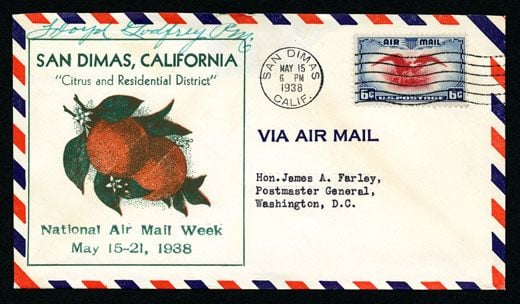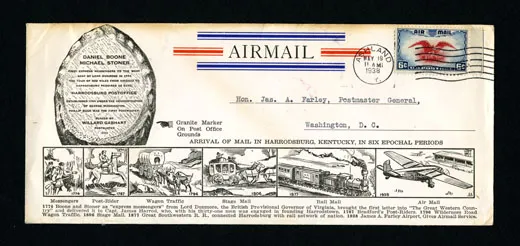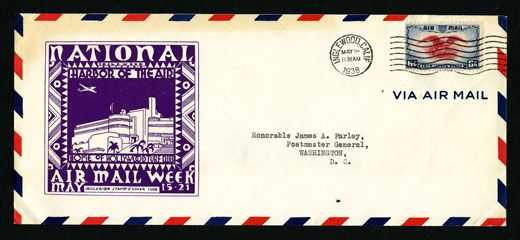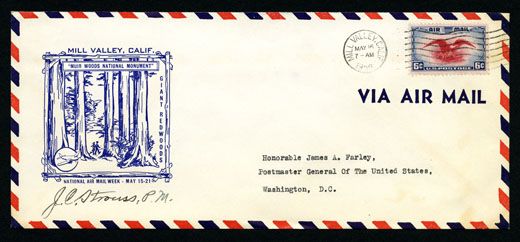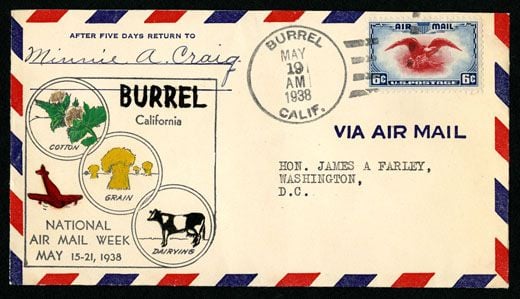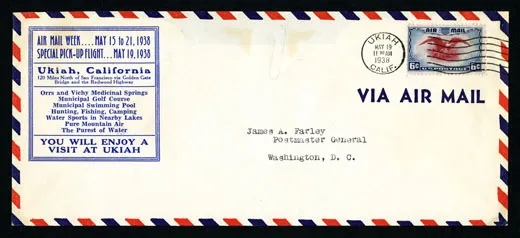“Receive To-morrow’s Mail To-day!”
For an entire week in 1938, the country celebrated airmail.
/https://tf-cmsv2-smithsonianmag-media.s3.amazonaws.com/filer/d9/7d/d97dc886-0659-4c5e-b2dd-5918601afbbe/airmail_cover_edited_800.jpg)
Not even the most astute bookie could have predicted the outcome. One fine spring morning in May, four carrier pigeons were pitted against an Eastern Airlines transport airplane traveling a 200-mile route from Washington, D.C. to New York. Unexpectedly, the birds were in the lead. As the New York Journal and American reported, “The wing-weary birds, their feathers drooping, swooped down on [the] Journal and American Building a half hour before their man-made competitor slithered to a stop at Newark Airport.”
Well, the birds had been given a head start. It was 1938, and a nation in the midst of the Great Depression decided to commemorate the 20th anniversary of airmail service with a weeklong celebration. The spirit of goodwill was so great that it extended even to the lowly pigeon.
The brainchild of Postmaster General James A. Farley, Air Mail Week encouraged every U.S. citizen to send an airmail letter during the celebration, which ran from May 15 to 21.The campaign had a catchy slogan: “Receive To-morrow’s mail to-day!,” and a new six-cent airmail stamp featuring a spiffy eagle. There were essay and poster contests (child star Shirley Temple even entered the children’s competition), and rousing speeches. The Boy Scouts, college fraternities, civil, fraternal, and veteran organizations were all asked to pitch in. Such was the fervor that 600 reams of paper were consumed in the New York State postal headquarters alone. Each town across the nation was invited to create its own cachet, a commemorative design or slogan that would be printed on the envelopes mailed on May 19, the highlight of the celebration. On that Thursday, airmail service would be provided to even the most remote locations, when pilots all over the country were asked to donate their services, and be sworn in as government employees for 24 hours.
The Nebraska State Historical Society’s Nebraska was divided into four districts (using Omaha, Lincoln, Grand Island, and North Platte as established stops on the transcontinental airmail route), additional routes were created. “Two major formats were used. The first was to have a plane start in a hub city, fly to three, four, or perhaps five towns, and then return to the hub with a cargo of airmail. Another option was to have a pilot start in his hometown and fly to the hub city, picking up mail along the way.” Local airports were used, but if a town didn’t have an airfield, folks made do with cleared fields and back roads.
It’s hard to imagine, in 2008, how thoroughly Americans embraced the project. The Hot Springs Arkansas Chamber of Commerce decided that sending one little letter was simply too pedestrian. Instead, they packaged up a bottle of their famous hot water, together with a bath outfit for President Franklin D. Roosevelt himself.
The California state postmaster, Leon L. Dwight, noted in his official report that “it was the most successful campaign ever in the history of the postal department in the Great Golden State of California, with some four and one half million air mail letters sent, and 3200 airmail packages. In the instance of the memorable day, May 19th, there were 90 special flights, with 129 pick up points covered, and the actual mileage flown was 5193 miles. Six of the 90 pilots, who so ably co-operated, were women.”
In Massachusetts, the pilots included Blanche Noyes, winner of the 1934 Bendix Trophy, and Edith Bernson, second in the 1934 Miami, Florida air races, and first-prize winner of the 1935 Amelia Earhart air races. New York pilots included Alma Harwood, known as “Flying Grandma,” and Roger Wolfe Kahn, a millionaire bandleader, as well as a priest and two doctors.
The states also were creative in how they got the mail to the airplanes. Helen Donahue, Maine’s state chairman, reported using “stage coach, old fashioned buck board, oxen teams, horseback riders as in the Pony Express days, and even foot runners as with the couriers of old. In fact every known means of transport was used, with a dog team at one office and at Rangeley, a reindeer team hauled the mail from post office to air field.” Illinois reported that the Chicago Post Office used an autogyro to carry the mail to and from the airport.
One New York town had just a bicycle at their disposal, but the Democrat and Chronicle still managed to make the prosaic means of transport exciting: “No hostile Indians, no desert wastes, no tortuous mountain trails beset the post rider yesterday...only modern traffic hazards, slippery street car rails and treacherous manhole covers slowed the expressman who defied historical accuracy by having a motorcycle escort for the entire trip.”
The Livingston, Montana, Chamber of Commerce decided to demonstrate the effectiveness of airmail by comparing it to the Pony Express, renting 12 horses from a dude ranch for the purpose. The run was from Livingston to Billings, a distance of 118 miles. It took the horses 11 hours and 50 minutes to make the trip; the airmail made the hop in 40 minutes.
Only one of the special flights crashed, and the Northern Star informed relieved readers that the New York pilot was unhurt, and that “after the crack-up at Lowville the airmail from the northern offices was taken to the post office...and continued on to Syracuse later.”
Paul Younts, postmaster of Charlotte, North Carolina, was appointed general chairman of Air Mail Week. In his official speech, he noted: “National Air Mail Week’s primary objective is to turn definitely the attention of the American people to this service, to given them a broader understanding of its value, to arouse in them a deserved appreciation of its already great and still increasing contribution to the national progress.... I am impelled to pay a tribute to the Wright brothers, whose genius and courage in their first flight on December 17, 1903, at Kitty Hawk, North Carolina, gave aviation to the Nation and the world. Air Mail Week will be a Nation-wide commemoration of that flight across the sandy shore from the Kitty Hawk dune, upon which now stands an impressive memorial of our Nation’s gratefulness.”
